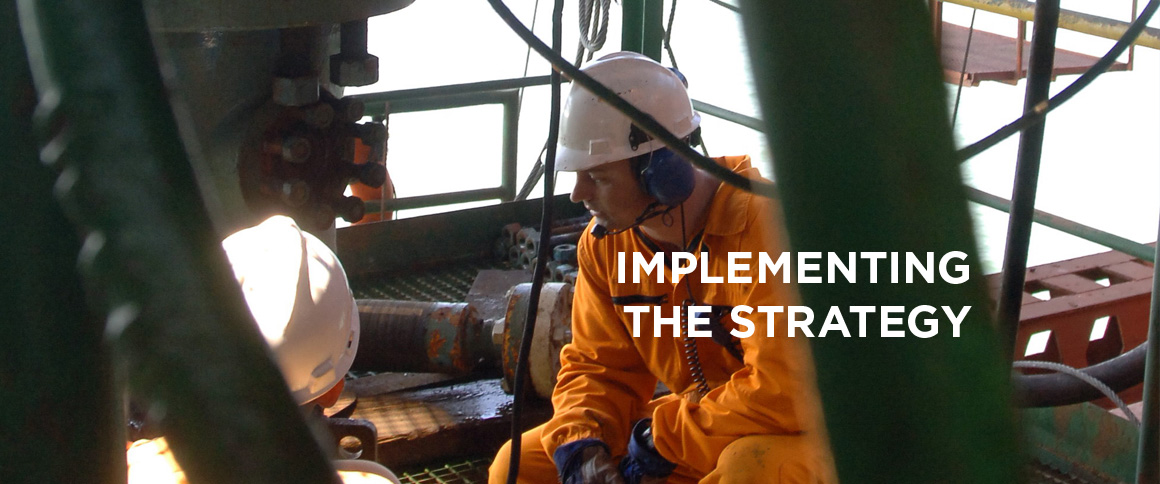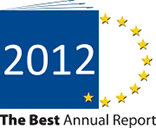

Grupa LOTOS S.A. - Integrated Annual Report 2012
Business environment
The global economic situation in 2012 was below market expectations. The largest world economies retained a slight growth, but growth rates were lower than in previous years.
In the developed nations, financial stability, production growth and declining unemployment were supported by actions introducing a more relaxed monetary policy and enhancing market liquidity. The principal source of prevailing uncertainty was that many countries found it difficult to implement balanced fiscal policies.
In 2012, the global economy continued to grow, but the growth rate (3.2%) was lower than expected (0.3pp below the forecast from July 2011). The forecast for 2013 has been affected by a slightly stronger downward correction (of 0.6pp), which has set the expected GDP growth rate at 3.3%.
Despite the remedial action taken by its Member States, the crisis in the eurozone remains the largest threat to the global economic revival. In 2012, the eurozone recorded a negative GDP growth rate of (-) 0.6%. Concurrently, a slight pickup in economic growth of 0.3% is expected in the Member States in 2013. 1
1 World Economic Outlook, International Monetary Fund, April 2013.
Source: In-house analysis based on IMF data (April 2013).
Source: In-house analysis based on Eurostat, OECD, and MFW data.
The economic difficulties and threats in the developed nations are to a large extent attributable to excess government debt, and will require further support in the form of appropriate monetary policy, conservative fiscal policy, and further structural reforms to overcome.
Situation in the refining sector
Despite adverse economic conditions, overall demand for crude oil increased (with a prevailing downward trend in consumption in the developed nations and higher consumption on the developing markets) 2, and crude prices went slightly up.
Industry organisations are estimating average demand for the commodity in 2012 at 89.2 mb/d, which is about 0.9% (0.8 mb/d) more than a year earlier. The average consumption of crude in 2013 is expected to come in at 90.1 mb/d, up 0.9%. 3 Medium-term forecasts by the International Energy Agency (IEA) predict that demand for crude will exceed 95 mb/d in 2017, meaning a compound annual growth rate (CAGR) of 1.3%.
2 Oil Market Report, IEA, November 2012.
3 In-house compilation based on OPEC, IEA and US EIA data.
IEA estimates indicate that the global growth is driven by rising demand for the commodity in developing countries. It is estimated that growth in non-OECD countries was 2.8% in 2012, and it is expected to remain at 2.6% (or 44.7 mb/d) in 2013. On the other hand, consumption in developing countries, which was down 1.1% in 2012, may decline by a further 0.7% (to 45.8 mb/d) in 2013. The IEA estimates indicate that these trends will prevail in the mid-term, that is, until 2017.
In 2012, crude oil consumption in Europe was estimated at 14.5 mb/d, while in 2013 it is expected that demand will drop to 14.3 mb/d. 4
Source: In-house analysis based on IEA data (December 2012).
Factors with a heavy bearing on the upstream sector in 2012 were oil and gas prices on the global markets, and fluctuating exchange rates.
A progressive change in the global energy mix, notably the expanding share of natural gas in US power generation, increased use of alternative, renewable energy sources, and the developing shale exploration and production industry, pushed gas prices significantly down. A similar trend may also be developing in crude oil supply and demand, particularly in that unconventional oil projects are apparently on the rise.
In addition, resources available at low production cost are being increasingly depleted. New deposits require a lot more capital outlay, which drives up the per-barrel price of the oil produced. At present, hydrocarbon exploration and production activity is concentrated in the US shale plays, offshore areas with deposits located at great depths, and offshore polar regions. The expected increase in production of oil and gas from said sources will require higher expenditure incurred per barrel of oil equivalent, which may find a reflection in hydrocarbon market prices.
The prices of crude oil and natural gas on the global markets will depend on how strong each of the two opposing trends become, bearing in mind the overall economic climate.
International fuel market ⁵
It is estimated that the demand for oil refining products rose in 2012 by 0.7% globally, while stronger demand will be recorded in the gasolines (0.6%) and diesel oil (0.8%) segments. The estimated consumption of LPG and light fuel oil also increased (by 1.2% and 1.8%, respectively). However, the demand for JET fuel will fall slightly (-0.4%).
4 Oil Market Report, IEA, November/December 2012.
5 Mid-Term Oil Market Outlook 2012-2017, JBC Energy, October 2012.
Source: In-house analysis based on JBC data, October 2012.
Source: In-house analysis based on JBC data, October 2012.
According to forecasts, the overall global consumption of refining products is expected to grow by over 5% until 2017. A significantly higher demand for diesel oil, LPG and JET fuel has been estimated (up by 14%, 10% and 8%, respectively, with 2012 as a point of reference). The consumption of gasoline should remain relatively unchanged, while a drop in consumption of light fuel oil (-13%) is also predicted.
Source: In-house analysis based on JBC data, October 2012.
Consumption of petroleum products in Europe is estimated to decline in 2013 by nearly 3%, affecting all product groups: gasolines (-4.9%), diesel oil (-1.2%), JET fuel (-2.9%), LPG (-2.7%) and light fuel oil (-2.2%). The lower consumption of petroleum products in Europe reflects the economic difficulties in the EU Member States and the eurozone.
The demand for oil refining products is forecast to fall in Europe by 3% until 2017. According to estimates, one of the reasons behind this decline will be a significant drop - of nearly 14% - in consumption of gasolines. Lower consumption is also expected on the light fuel oil market (-16%). Concurrently, a strong increase in consumption of middle distillates is expected: diesel oil by 2.1%, and JET fuel by 2.8%.
In the European car market, new passenger car registrations fell significantly (by 7.8%) in 2012, to 12.5m new cars, whereas in the utility vehicles segment, new registrations declined 11% to 1.6m vehicles (for January-November). In the registered new passenger cars group, increasing interest in diesel cars has been observed since 2009. The share of diesel cars in total new car registrations in Western Europe was nearly 60% (compared with 46% in 2009). 6
6 European Automobile Manufacturers’ Association, www.acea.be
Poland – macroeconomic environment
In 2012, GDP growth in Poland slowed down. According to estimates, in real terms the GDP grew by just 2.3% over 2011, the slowest growth rate since 2009. This is chiefly attributable to weaker domestic demand and lower industry and construction output sold. Additionally, inflation was down to 3.7%.
The economic slowdown in Poland in 2012 is expected to be accompanied by higher unemployment. According to market estimates, the jobless rate was 13.4% in 2012, which represents a 0.9pp rise on the previous year. In 2012, salaries and wages in the non-financial corporate sector increased by 3.4% compared with 2011, which did not translate into stronger purchasing power.
Polish fuel market
Despite the previous upward trend in diesel oil consumption in Poland, growth of demand for the fuel was negative in 2012. This is believed to have been caused by the economic slowdown, and in particular by the weaker performance from the construction and transport industry than in prior years, as well as lower growth of domestic demand. The average annual retail price of diesel oil has grown rapidly over the last few years. In 2011, the growth rate was 18.1% and a year later 12.5% (according to preliminary data). As a consequence, the price per litre as at the end of 2011 soared to almost PLN 5.60, which proved to be the point beyond which consumers cut back on their diesel oil consumption. Preliminary estimates show that compared with 2011, diesel oil consumption fell 9.4% in 2012, to just above 12m tonnes.
Similarly to other European countries, the demand for gasoline declined for another consecutive year, driven by continuous price growth since 2009, weaker purchasing power and better fuel efficiency of vehicles in Poland. Another factor was the dieselisation of vehicles. For 2012, the demand for gasoline in Poland was estimated at 3.8 million tonnes. Accordingly, negative growth is projected at (-)5.1%, down 0.6pp relative to a year ago.
Given the high prices of gasoline, the less expensive LPG alternative fuel has gained popularity. More than 2.2m tonnes of LPG are estimated to have been sold in 2012, which means that, contrary to 2011, demand for the fuel is up (2.9% growth). For several years now, the demand for light fuel oil has weakened following the popularity and availability of other heating fuels in Poland. According to preliminary estimates, light fuel oil consumption in Poland in 2012 was just under 950,000 tonnes, down 13.9% on 2011.
Source: In-house analysis of Polish Organisation of Oil Industry and Trade (POPiHN) data.
The demand for diesel oil, gasoline, LPG and light fuel oil is estimated to drop in aggregate by approximately 7% in 2012. No significant improvement is expected in this area in 2013.
It is estimated that growth in the number of passengers served by Polish airports in 2012 accelerated compared to 2011, mainly as a result of the EURO 2012 football championship. This increase precipitated a rise in aviation fuel consumption. Preliminary data shows that in 2012, demand for aviation fuel pushed past 490,000 tonnes, which is 1.4% more than in 2011. Over the last few years, the number of passengers using Polish airports has grown, which has resulted in an average annual growth rate of JET fuel consumption of 5%..
Polish retail fuel market
Source: Polish Organisation of Oil Industry and Trade (POPiHN).
At the end of 2012, there were about 6,700,000 service stations in Poland. 7 The year saw continued consolidation of the retail segment and optimisation of the station chain in Poland. Major moves in that direction included the acquisition by Shell of 106 Neste service stations.
Compared with the preceding year, the number of stations owned by both Polish and international corporations increased, while concurrently there was a drop in the number of stations owned by independent operators. Among those who remained on the market, there was a marked trend to join large service station chains.
Expansion of Poland's motorway network has been accompanied by the appearance of a growing number of motorway stations. At the end of the year, there were 43 Motorway Service Areas (MSAs) in Poland. 8
LOTOS Optima recorded a marked growth in the economy segment. At the end of 2012, there were 101 stations operating under this brand, nearly twice as many as at the end of 2011.
7 Based on data from the Polish Organisation of Oil Industry and Trade (POPiHN).
8 Based on data from the Polish Organisation of Oil Industry and Trade (POPiHN).

 E-mail
E-mail Facebook
Facebook Google+
Google+ Twitter
Twitter
